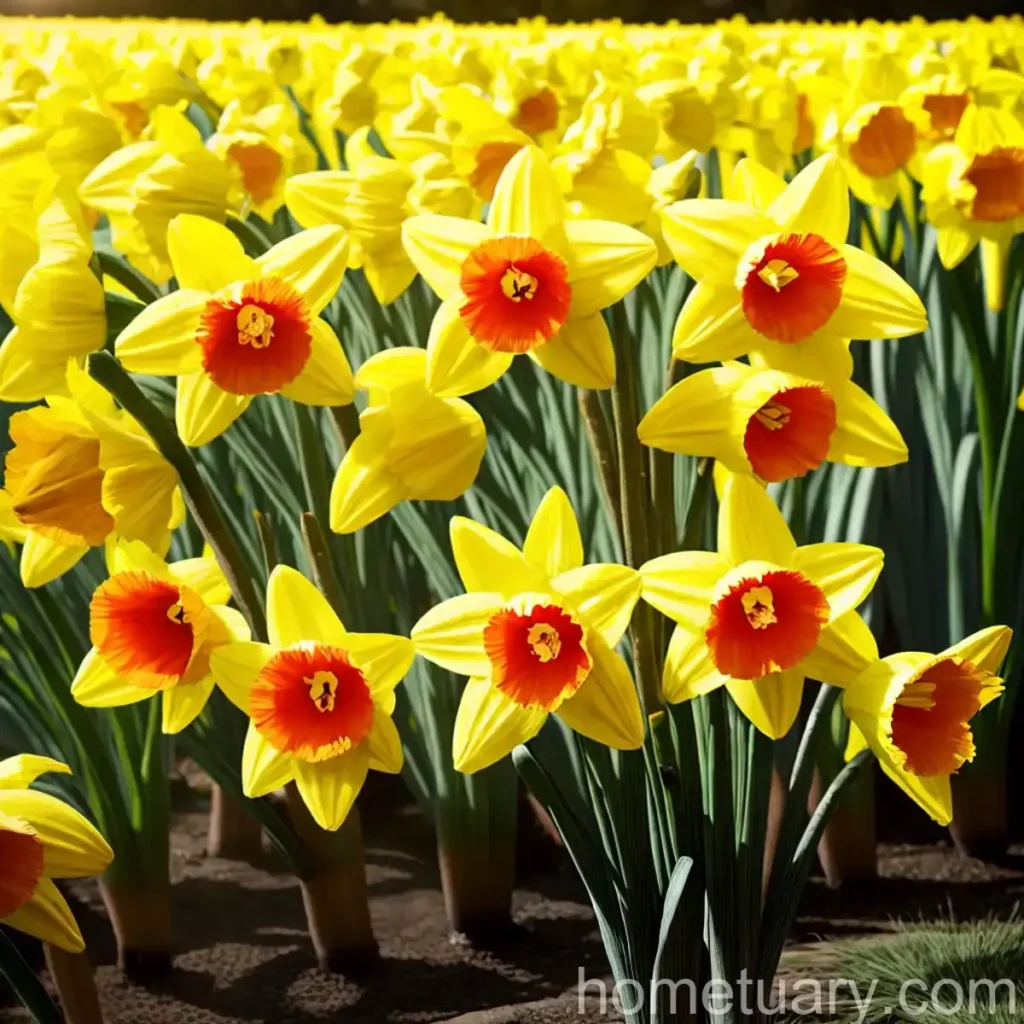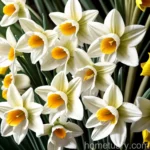The Large-cupped Daffodil (Narcissus ‘Ring of Fire’): A Beautiful Spring Flowering Plant
The large-cupped daffodil, known scientifically as Narcissus ‘Ring of Fire’, is a stunning spring-flowering bulbous plant that belongs to the Amaryllidaceae family. This beautiful variety of daffodil is prized for its impressive blooms, which feature a large, trumpet-shaped cup surrounded by gracefully reflexed petals. In this comprehensive guide, we will explore the various aspects of the large-cupped daffodil, including its cultural requirements, uses, maintenance, common diseases, and much more.
What is the Large-cupped Daffodil (Narcissus ‘Ring of Fire’)?
The large-cupped daffodil, Narcissus ‘Ring of Fire’, is characterized by its striking blooms and is a popular choice for spring gardens. With its vibrant colors and elegant form, this daffodil variety adds a touch of natural beauty to any landscape. The flowers typically feature a large, ruffled cup that contrasts with the surrounding petals, creating a captivating visual display.
Key Takeaways – Large-cupped Daffodil (Narcissus ‘Ring of Fire’)
Before delving into the specific details of caring for the large-cupped daffodil, let’s highlight some key takeaways about this exquisite plant:
- Narcissus ‘Ring of Fire’ is a stunning large-cupped daffodil variety with vibrant, eye-catching blooms.
- This spring-blooming daffodil is prized for its attractive appearance and is a favorite in home gardens and floral arrangements.
- The plant has specific cultural requirements related to water, sunlight, fertilizer, soil, and pruning for optimal growth and flowering.
- The large-cupped daffodil can be propagated through methods such as division and seed sowing, providing opportunities for expansion and cultivation.
- Despite its beauty, the plant is susceptible to certain diseases and pests that may impact its health and blooming potential.
Now let’s explore each of these aspects in greater detail.
Culture
Successful cultivation of the large-cupped daffodil, Narcissus ‘Ring of Fire’, requires attention to various cultural practices, including watering, sunlight exposure, fertilization, soil conditions, and pruning techniques.
Uses
The large-cupped daffodil, with its striking blooms and vibrant colors, serves various purposes in horticulture and landscaping. Some of its common uses include:
- Ornamental Planting: The daffodil’s captivating appearance makes it an ideal choice for ornamental gardening, adding color and elegance to flower beds, borders, and naturalized areas.
- Floral Arrangements: The cut flowers of the large-cupped daffodil are widely used in floral arrangements, bouquets, and indoor displays, bringing the beauty of the spring garden indoors.
- Landscape Design: In landscaping, these daffodils can be incorporated into garden designs, creating stunning displays when mass-planted or combined with other spring-flowering bulbs and perennials.
Water
Appropriate water management is crucial for the health and vigor of the large-cupped daffodil. While the plant requires regular watering, proper drainage is equally important to prevent waterlogged conditions that can lead to root rot and other issues.
- Watering Tips:
- Provide consistent moisture during the growing season, especially when the plant is actively producing foliage and developing flower buds.
- Avoid overwatering, particularly in heavy or clay soils, to prevent water stagnation around the roots.
Sunlight
Sunlight exposure greatly influences the growth and blooming of the large-cupped daffodil, as it is a sun-loving plant that thrives in bright, sunny conditions.
- Sunlight Requirements:
- Plant in a location that receives at least 6-8 hours of direct sunlight daily for optimal flower production.
- Ensure that the chosen planting site offers adequate natural light to support the daffodil’s photosynthetic needs.
Fertilizer
Proper fertilization plays a vital role in promoting healthy growth and robust flowering in the large-cupped daffodil. By providing essential nutrients, fertilizers support the plant’s overall vitality.
- Fertilization Guidelines:
- Apply a balanced, slow-release fertilizer in early spring before the daffodils start actively growing to support their initial growth stages.
- Avoid excessive application of high-nitrogen fertilizers, as this can lead to lush foliage at the expense of flower production.
Soil
The soil conditions significantly impact the growth, development, and overall performance of the large-cupped daffodil. Well-draining, fertile soil is essential for successful cultivation.
- Soil Requirements:
- Plant daffodil bulbs in well-draining loamy or sandy soil with a neutral to slightly acidic pH for best results.
- Amend heavy clay soils with organic matter such as compost to improve drainage and enhance soil structure.
Pruning
Pruning practices are essential for maintaining the health and appearance of the large-cupped daffodil. Proper pruning not only enhances the plant’s aesthetic appeal but also contributes to its long-term vitality.
Pruning Guidelines
- Deadheading:
- Remove spent flowers promptly to prevent the plant from expending energy on seed production, allowing it to allocate resources toward bulb development.
- Deadheading also improves the overall appearance of the plant and prevents the formation of seed pods.
Propagation
Propagating the large-cupped daffodil offers an opportunity to multiply the plants and expand their presence in the garden. There are several methods of propagation to consider for cultivating new daffodil specimens.
- Division:
- Divide established clumps of daffodils every 4-5 years in late summer to early fall, when the foliage begins to yellow and die back naturally.
-
Carefully lift the clumps, separate the bulbs, and replant them at the desired spacing and depth to allow for future growth and blooming.
-
Seed Sowing:
- Collect mature seeds from daffodil pods and sow them in well-prepared seed beds or containers for germination.
- Provide consistent moisture and protection from extreme temperatures to support the successful establishment of seedlings.
Container Popularity
The large-cupped daffodil is also a popular choice for container gardening, offering versatility in terms of display options and adaptability to various growing environments.
- Container Gardening Tips:
- Select well-draining containers with adequate drainage holes to prevent waterlogging and maintain healthy root conditions.
- Plant daffodil bulbs at the appropriate depth and spacing in the containers, ensuring that the soil provides sufficient support for root development.
Common Diseases
Despite their overall hardiness, large-cupped daffodils are susceptible to certain diseases and disorders that can affect their growth and flowering.
Disease Diagnosis
- Fungal Diseases:
- Common fungal issues, such as botrytis (gray mold) and fusarium, may affect the foliage and bulbs of daffodils, leading to discoloration, decay, and reduced vigor.
-
Monitor the plants for signs of fungal infections, such as discolored or withered foliage, and take appropriate measures to address the issues promptly.
-
Viral Infections:
- Daffodils can also be affected by viral diseases, which may manifest as mottled or distorted foliage, stunted growth, and reduced flower quality.
- Maintain good garden hygiene and promptly remove and destroy any infected plant material to prevent the spread of viral pathogens.
Common Pests
In addition to diseases, large-cupped daffodils may also face challenges from various pests that can impact their health and performance.
- Pest Management:
- Keep an eye out for common pests such as aphids, thrips, and bulb fly larvae that may target the foliage, flowers, or bulbs of daffodils.
- Use appropriate pest control measures, including insecticidal soaps and natural predators, to mitigate pest pressure and protect the plants.
Botanist’s Tips
For enthusiasts and gardeners seeking to cultivate and care for the large-cupped daffodil, consider these valuable tips from botanists and experienced horticulturists:
- Selecting Bulbs:
- When purchasing daffodil bulbs, choose firm, healthy specimens and avoid bulbs that show signs of rot or damage.
-
Opt for larger bulbs, as they tend to produce stronger, more robust plants and better flower displays.
-
Naturalizing Daffodils:
-
For a naturalized look, plant daffodil bulbs in clusters or drifts rather than in uniform rows, creating a more organic and visually appealing arrangement.
-
Mulching:
- Apply a layer of organic mulch, such as compost or shredded bark, around daffodil plantings to conserve soil moisture and suppress weed growth.
Fun Facts
While appreciating the beauty of the large-cupped daffodil, consider these fascinating facts about this distinct plant:
- Daffodils are associated with positivity, renewal, and the arrival of spring, making them a symbol of hope and new beginnings.
- The large-cupped daffodil belongs to a diverse genus that includes numerous species and cultivars, showcasing a wide range of colors and forms.
- Daffodils contain toxic compounds that make them unpalatable to most animals, serving as a natural deterrent against grazing damage.
Links to External Resources
For further exploration of the large-cupped daffodil and related topics, consider the following external resources:
- The American Daffodil Society: https://daffodilusa.org/
- Royal Horticultural Society (RHS) – Growing Daffodils: https://www.rhs.org.uk/plants/popular/daffodil/growing-guide
- University of Minnesota Extension – Daffodils in the Garden: https://extension.umn.edu/flowers/daffodils-garden
In conclusion, the large-cupped daffodil, Narcissus ‘Ring of Fire’, is an enchanting spring-flowering plant that captivates with its vibrant blooms and elegant form. By understanding and implementing the appropriate cultural practices, enthusiasts can enjoy the beauty and charm of these daffodils in their gardens, landscapes, and floral arrangements.
Keywords:
1. Narcissus ‘Ring of Fire’ daffodil
2. Large-cupped daffodil
3. Beautiful daffodil varieties
4. Spring flowering daffodil
5. Narcissus flower
6. Daffodil bulbs
7. Narcissus cultivars
8. Daffodil plant care
9. Narcissus ‘Ring of Fire’ characteristics
10. Growing large-cupped daffodils
11. Daffodil gardening
12. Narcissus varieties
13. Daffodil species
14. Daffodil propagation
15. Narcissus ‘Ring of Fire’ care tips
16. Large-cupped daffodil facts
17. Planting daffodil bulbs
18. Narcissus ‘Ring of Fire’ blooms
19. Daffodil symbolism
20. Narcissus ‘Ring of Fire’ garden display
21. Daffodil landscaping ideas
22. Narcissus ‘Ring of Fire’ seasonality
23. Daffodil pests and diseases
24. Narcissus ‘Ring of Fire’ container gardening
25. Large-cupped daffodil arrangements
26. Daffodil companion plants
27. Narcissus ‘Ring of Fire’ hybridization
28. Growing daffodils in pots
29. Narcissus ‘Ring of Fire’ garden design
30. Daffodil flowerbed ideas
31. Narcissus ‘Ring of Fire’ naturalizing
32. Large-cupped daffodil fragrance
33. Daffodil bouquets
34. Narcissus ‘Ring of Fire’ landscape uses
35. Daffodil folklore
36. Narcissus ‘Ring of Fire’ perennial planting
37. Daffodil bed maintenance
38. Narcissus ‘Ring of Fire’ bulb storage
39. Large-cupped daffodil in home gardens
40. Daffodil repotting tips
41. Narcissus ‘Ring of Fire’ outdoor cultivation
42. Daffodil cut flowers
43. Narcissus ‘Ring of Fire’ late season beauty
44. Daffodil division techniques
45. Narcissus ‘Ring of Fire’ bloom colors
46. Daffodil edging and borders
47. Narcissus ‘Ring of Fire’ garden center availability
48. Daffodil indoor arrangements
49. Narcissus ‘Ring of Fire’ planting depth
50. Daffodil water and soil requirements















